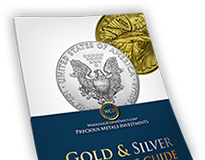
Why the “Silver Squeeze” Didn’t Work
There has been a huge amount of media attention given to a possible short squeeze developing in the silver futures market, following the apparent success of such activity in the equities markets. Adherents of this short squeeze theory see the silver price being pushed ever higher and, as a result, the opportunity to make huge gains through investment in the metal.
But the reality of this latest attempt to drive the silver price up significantly has been somewhat different. After a short-lived upwards surge to a little above $30 an ounce, silver quickly came back down to its prior levels – or below them – alongside a weak gold price. This just confirmed the opinions of some analysts and commentators that the likelihood of the silver short squeeze price boost theory is unlikely to have any success. The below article looks at some of the weaknesses in the generally bullish media arguments promoting silver investment.
Not for nothing, silver is referred to by some traders as the “devil’s metal.” Historically speaking, the path of the silver price is littered with similar attempts to drive it upwards. These moves, when they have occurred, have always led to those opportunists who climbed on the silver bandwagon eventually getting their fingers severely burnt. The out-and-out silver bulls will tell you that silver should be priced at around one-sixteenth of the gold price, per its historic price relationship with the premier precious metal. But this price relationship dates back to the days when silver was, like gold, a monetary metal. Currently, silver is much more an industrial metal, with virtually all its monetary usage confined to history. A perhaps more appropriate valuation parameter would be around one-sixty-sixth of the gold price – the approximate average of the price relationship between the two metals over the past 20 years or so, and somewhere near the level it is sitting at now.
There are those out there who will very strongly counter the arguments of the perhaps more fanatical silver bulls, and while the arguments they put forward may differ somewhat from one another, they do tend to revolve around the tight controls exerted on the silver market by the key bankers and traders holding the huge, short positions. This may be viewed by some as market manipulation, but then, all markets are almost certainly manipulated to some extent by those with the biggest monetary stakes in them. Silver is not likely to be any different in this respect. Such “manipulation” is a fact of financial life, so one probably needs to take this idea into account and work around it, while also recognizing the huge financial funds to which those who exert the price controls have access. This makes trying to squeeze the silver shorts a much more difficult exercise than squeezing equity market short sellers and would require an absolutely massive monetary investment to do so. Indeed, this would require access to funds probably beyond the combined capacity of those who may have been involved in the recent attempted silver short squeeze, such as it was.
The idea behind the silver short squeeze is fairly straightforward: the short position held by various financial entities is much larger than the inventory of physical metal they hold. Therefore, because of regulatory rules requiring the financial entities to deliver on certain amounts of physical metal per stock, all the squeezers have to do to get the silver price to rocket higher is to generate enough demand in the market that the financial entities holding the short position wouldn’t be able to meet their obligations of physical metal delivery. At that point, they would be forced to buy more silver to cover their positions, which would cause the short squeeze to begin and, in turn, would force the silver price ever upwards. This breaks down in that investors are, firstly, not equipped to handle the vast volumes of silver bullion that would be involved, were they to take delivery, and secondly, the holders of the balancing long positions just roll these positions forwards, having never had the intention of taking delivery of the metal anyway.
The above is the conclusion of a blog post from a well-known commentator who prefers to remain unidentified. His views are often outspoken, but he is a valuable source of information on sectors of the global mining industry. His take on the silver market and how it operates is illuminating and certainly worthy of close consideration.
Somewhat cynically, the silver squeeze idea is also rejected by the same commentator to the financial powers that be by promoting the theory behind the idea as a means to suck the gullible investor in, relieve him or her of currently held investments, and line the commentator’s own pockets accordingly. I suppose that, given the way financial markets seem to always play out in favor of the big money, this theory may be simplistic, but perhaps also not too ridiculously far-fetched. Capitalism is a far-from-perfect system and is thus ever prone to manipulations of this type.
The commentator responsible for the above opinions is not the only one out there expressing a particularly jaundiced view of much of the investment hype that afflicts the silver market. Jeff Christian, who heads up the hugely respected New York consultancy, CPM Group, also feels that much of the silver hype has been hugely overdone. The group, in a recent webinar, notes that media and messaging surrounding precious metals markets, in general, continue to be flooded with bad information, inaccurate data, flawed analyses, and biased commentary.
The CPM Group, in its analyses and recommendations, has a particularly good history of predicting the ups and downs in silver prices, so cannot be accused of being consistently bullish or bearish on the metal. Its most recent recommendation has been positive, but was made several weeks ago, before the recent sharp up-and-down movement in the metal price. Christian has frequently warned that the reasoning behind much of the bullish argument expressed regarding the big silver short positions on the COMEX exchange is both faulty and misleading. He comments that the bullion banks, which hold the big short positions and also, often, big inventories of physical metal, make their money not based on actual metal price movement, but on amassing small cumulative percentages of the value of silver trades themselves, regardless of whether the price moves up or down.
Christian also makes the point that the surges seen last year in holdings of gold and silver-based ETFs, which were seized upon by some commentators as being extremely bullish for gold and silver, were, in effect, largely an accounting adjustment by the bullion banks. This enabled them to move commodity bullion holdings into other bank divisions that handle equity and ETF investments in order to meet internal policy parameters.
Industry doyen, Pierre Lassonde, has also picked up on the supposed silver short squeeze situation. In a recent interview with Bill Powers, Lassonde commented that “[t]here are no short positions. The commercial banks, they will short on one market and they will go along [sic] on the other market, but they never, never go naked. So this idea that there’s a huge giant short position in a silver market is completely loony tuney.”
So where does the writer stand on silver and silver investment? Although it may seem illogical, given their very different markets nowadays, the silver price tends to have a close ongoing relationship with movements in the gold price – often expressed in the Gold:Silver Ratio (GSR). (This effectively is a mathematical representation of the number of ounces of silver equivalent in price to one ounce of gold.) Historically, the silver price has tended to follow the gold price, but in an exaggerated manner. Thus, in a rising gold price scenario, the silver price tends to rise – but slightly faster, in percentage terms. Conversely, when the gold price falls, the silver price falls, again, more severely, in percentage terms.
The current GSR is around 67 as I write, which means it is close to the average seen over the past 20 years or so, although it has fluctuated between around 120 on the high side and 30 on the low. The 120 and 30 levels are the extremes and should thus be considered anomalous, but they do demonstrate silver’s enormous volatility vis-à-vis gold.
Given that I see some strength ahead in the gold price, despite its recent mark downs to below $1,700, I also have to remain positive on the silver price looking ahead to later this year and beyond. However, I wouldn’t put the likely price peak much beyond $30 this calendar year – and even that might be a stretch, given recent market activity. Recent investment losses may well have reduced investor interest in silver as being too much of a gamble going forward, which may serve to dampen investor enthusiasm and thereby limit price advance.






